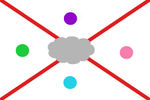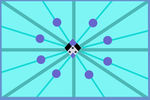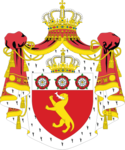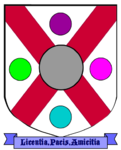Republic of Bokonton
Republic of Bokonton | |
|---|---|
| Motto: Freedom, Peace, Friendship | |
| Anthem: Bokonton, the Brave and Strong | |
| Location | Great Britain |
| Capital | Natillyah |
| Official languages | English |
| Demonym(s) | Bokontonian |
| Government | Monarchy (de facto) Republic (de jure) |
• Monarch | The Queen of Bokonton |
| Establishment | 28 October 2007 |
| Population | |
• Census | 20-30 |
| Currency | Bokonton Zii |
| Time zone | UTC |
The Republic of Bokonton (formerly known as the Republic of Biokinton) was a territorial micronation located in the south west of England. Bokonton was founded on 28 October 2007 by its leader Evren Filgert, who remained its sole leader throughout its existence. The micronation effectively collapsed in late 2010, and its former capital became the Austenasian Town of Porthbokon.
Etymology
Soon after founding, Bokonton's name was changed as the name "Biokinton" was resemblant of the Super Mario Land boss of the same name. The micronation was judged negatively due to this initial name, prevented from joining many intermicronational sites and due to micronational-peer pressure had to drop the name.
History
The Republic of Bokonton was founded on 28 October 2007 by Evren Filgert, who became its Queen (she did not use her current name at the time).
A "War with Putneystan" began in May 2008, from which Bokonton had emerged victorious by September/October later that year. After peace talks, Putneystan was annexed by Bokonton in late 2008. Launcestonia and the Launcestonian Gardens were annexed in January 2009. Orkadland was annexed before Launcestonia, probably alongside or soon after Putneystan.
Bokonton joined the Grand Unified Micronational on 23 May 2009. It later joined the Organisation of Active Micronations in March 2010, but withdrew along with four other members in the June 29th Incident.
By May 2010, Bokonton no longer controlled Launcestonia and the Launcestonian Gardens. After a rocket launch in July 2010, activity by the government seems to have rapidly decreased, with control over all but Natillyah being lost by the end of 2010. Bokonton is thought to have existed in name only by May 2012.
Government and politics
As the Republic of Bokonton was only a de facto republic in its early founding days, confusion, embarrassment, and many misunderstandings resulted as it took on the characteristics of a monarchy despite remaining a de jure republic. In August 2009 Bokontonians began referring to it as a Kingdom, but a name change was never officially instigated.
Bokonton always remained a republic and although ruled by a monarch, operated with the Monarch as a provisional ruler. If enough citizens had formed their own political party and announced their intention to have a democratic election, the monarch would have stepped down.
Foreign relations and military
Bokonton employed a ParaTroop Service, but this was used strictly for intelligence missions and the force only included two parachutes. It was based in Natillyah, and was also known as the Royal Bokonton Air-Force.
The Republic of Bokonton was allied with:
Bokonton was a member state of:
Geography
In May 2009, Bokonton controlled five territories:
- Natillyah (formerly spelt Natilla), known as the Western Territory and represented by purple on the Royal Flag. The capital of the Republic and location of the home to the Queen, the Royal Palace. Situated in Cornwall, and now known as Porthbokon.
- Putneystan, also known as the Eastern Territory, represented by pink. Home to the "Lesser Royal Family", a war had been fought over the land from May 2008 until September/October 2008, from which Bokonton emerged victorious. Situated in Putney.
- Orkadland, also known as the Southern Territory, represented by blue. Holiday home of the "Lesser Royal Family", it was governed by Viceroy Thomas. Situated on the Isle of Wight.
- Launcestonia, close to the Launcestonian Gardens, both represented by green. The lands were presented to Bokonton by Lady Lilia, and a naval base was founded in Launcestonia on 18 May 2009. Both situated in Cornwall, close to the border with Devon.
By May 2010, Bokonton had lost control of Launcestonia and the Launcestonian Gardens. Citizens of Bokonton (who joined through the micronation's website or by contacting the Foreign Affairs minister by e-mail, message-board etc.) were invited to declare a room, or indeed their entire house, to be an embassy for the country by taking a photograph displaying Bokonton's flag within their dwelling, a style made popular by such micronations as the Kingdom of Lovely and used by others such as the Slinky Empyre.
Economy
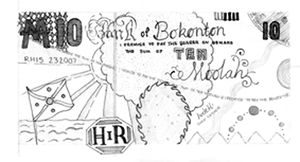
Bokonton used the Moolah (pronounced MOO-Lah), also known as the Bokonton Dollar, which was traded inside the nation and was equivalent to 1.5 GBP and 2.14 USD; each Moolah consisted of 100 Zii (pronouced ZEE), the Bokonton Penny. Bokonton planned to issue stamps and physical coins/notes, but the progress made on these initiatives is unknown.
Bokonton circulated both the Moolah and the British pound sterling (£), but had hoped to become financially independent, with the GBP being gradually phased out of Bokonton. It was announced in April 2009 that Bokonton was finalising details for the design of a Ten Moolah note with a banknote artist, some of which had been made by July later that year.
Culture
The national animal of Bokonton was the otter, the national bird the Japanese quail, the national flower the Chocolate Cosmos, and the national tree the beech. The national instrument was the thumb piano, and the national sport was Bob Shopping, believed to involve travelling in shopping trolleys.
Religion
Bokonton was a secular state, with religion being the personal choice of each citizen. Both Nortonism and Christianity were well-practised within the micronation, and many citizens were atheists.
National symbols
Bokonton had two flags, the National Flag and the Royal Flag. The Royal Flag, which was adopted at some point between January and September 2009, consisted of a grey cloud in front of a red saltire on a white background, these three colours being the national colours of Bokonton. Between each arm of the saltire was a coloured dot, each representing an area of Bokonton (see above).
The National Flag was adopted in September 2009 to represent Bokonton, consisting of the three national colours in horizontal stripes of red, grey and white. The old flag became known as the Royal Flag and was used to represent the Queen, who also had a Royal Crest.
-
National Flag.
-
Royal Flag.
-
A "naval flag", presumably adopted for the base in Launcestonia.
-
The original Royal Crest.
-
The second Royal Crest, adopted in April 2009.
-
An early government crest.
-
The arms of the Royal Family.
Media
The only known Bokontonian source of news was the Bokontonian News Service, a media conglomerate operated by members of the Bokontonian Goverment. This produced a quarterly newsletter named the Bokonton Times, and ran an online news service via Twitter. The Bokonton Times stopped publishing by the start of 2010, and was re-launched as a newspaper named after the News Service itself in April 2010, continuing to publish into July.



